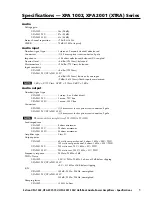
Calibration — Type Z
REGION OF
OVERLAP
1 1 4 - 4- i t 4 1 4
1 I 1 1
Fig. 5-5. “ Double
triggering”
the waveform
permits
attenuator
compensation adjustments to be made quickly and accurately. W ave
form photograph shows result when the A VOLTS/CM input-capaci
tance trimmer is correctly adjusted.
Fig. 5-6. Effect of the output voltage divider compensation adjust
ments when incorrectly adjusted.
When adjustments are correct,
waveform should appear similar to Fig. 5-5.
adjust the Variable Time/cm control to obtain a stable
display of several overlapping waveforms. Adjust the out
put voltage divider compensations C7655 and C8655 for
best square leading corner at the bottom side of the square
wave. The capacitors should be adjusted in equal incre
ments so they will be at approximately the same physical
setting. Fig. 5-6 shows typical appearance of waveforms
when C7655 and C8655 are not correctly adjusted. When
adjustments are set correctly, the waveform should look
like Fig. 5-5. Set the Mode switch to A O N LY. Disconnect
the signal from the B input connector and connect it to the
A input. Check to see if C7655 and C8655 are adjusted
to give the best possible square leading corner at the top
of the displayed square waves. If the capacitors need to
be readjusted, adjust them for the best compromise between
the two displays.
Keep the capacitors at approximately
the same physical settings in relation to each other. Be
cause of adjustment interaction, repeat steps 12 and 13
before going on to step 14.
14. Turret Attenuator Compensation
Place the A VOLTS/CM control to the .1 position. Set
the oscilloscope Time/cm switch to .5 millisec. Decrease the
square-wave generator frequency to 1 kc and adjust the
generator output amplitude for approximately 3.5 cm de
flection on the crt. Adjust the SERIES trimmer for the most
nearly square corner on the leading edge. Then adjust the
SHUNT trimmer to make the flat tops of the waveform as
level as possible. Recheck the SERIES adjustment for the best
square leading corner. Set the attenuator to the next posi
tion. Continue in this manner until the rest of the attenu
ator positions have been adjusted. Throughout this step,
adjust the generator output amplitude to keep about 3.5
cm of deflection for each position of the attenuator as long
as sufficient output can be obtained. Remove the "L" pad
for more amplitude during the higher attenuation posi
tions of the turret. After completing all the turret adjust
ments, check each position again to see if any “ touching
up" is necessary. Place the turret attenuator in its most
clockwise position and remount the outer knob to read .05.
Disconnect the signal from the A input connector and
apply it to the B input connector. Set the Mode switch to
— B O N LY and repeat the above procedure to adjust the
B VOLTS/CM attenuator compensation. Disconnect the gen
erator cable, “ L" pad, and capacitance standardizer.
15. Amplifier High-Frequency Compensations
Connect the 52-ohm cable to the Type 107 Square-Wave
Generator (or equivalent) output connector. Connect the
other end of the cable through a 52-ohm termination to
the B input connector on the Z Unit. Set the generator
output frequency to approximately 1 me and adjust the
amplitude for about -3.5 cm of vertical deflection. Set the
oscilloscope Time/cm switch to .1 /xsec. Display the nega
t e )
( b )
Fig. 5-7. (a) Appearance of input B waveform when L7632 and
L8632 are improperly adjusted, (b) Appearance of waveform when
all high-frequency compensations are correctly made.
5-5
Summary of Contents for TYPE Z PLIG-IN
Page 14: ...OVERALL G A IN 2 PUSH PULL I OUTPUT l I l Ci I Fig 3 1 Type Z Plug In Unit block diagram 3 0...
Page 18: ...NOTES Type Z...
Page 24: ...NOTES Type Z...
Page 32: ...NOTES...
Page 36: ...0 Parts List Type Z RIGHT SIDE 0 6 4...
Page 38: ...Parts List Type Z LEFT SIDE 6 6...
Page 44: ...NOTES...
Page 52: ......
















































